Many business owners forget that landing pages are an essential marketing tool that you can use for various reasons. Designing a website can be hard enough without including landing pages in the mix, after all.
Some of the most common uses for landing pages include growing your customer list with a lead generation landing page or telling your customers more about your products, whether you want to increase sales or educate your audience.
Designing landing pages can be tricky because you’ll need to aim for landing pages that convert. Getting your landing page to this stage can take a bit of effort. We promise that designing great landing pages is well worth the investment for your website; even if you’re after a minimalist website.
We’ll tell you everything you need to know about designing landing pages that convert so you can achieve business growth.

Firstly, what is a landing page?
A landing page is a single web page that serves one function for the end-user. Landing pages are commonly used when clicking on a search engine results page, marketing promotion, emails, or as the destination for many online ads.
Landing pages are also commonly used on social media. Additionally, the main goal of a landing page is to convert site visitors into sales or leads. If you are creating a lead generation landing page, you’ll need to provide a way for visitors to share their contact details with you, typically through a form that customers must complete.
Landing pages for sales usually redirect the viewer to purchase a specific set of items quickly. Later, marketers will assess the URL traffic and referral sources of landing pages to check if they were successful.
Benefits of designing landing pages
You may wonder what the benefits of designing landing pages could be for your website. Some of the advantages of well-designed landing pages include:
- An improved SEO ranking. Landing pages typically target a few specific search terms to appeal to your intended audience. You can also boost your landing page through other paid advertising, such as Google Ads or social media ads. These activities can improve your landing page’s ranking and get your product or service seen by more people.
- Promotion. Your landing page should focus on one item, whether it’s a new product/service, event or sale. Your landing pages will exist outside your main website pages, meaning they’re ideal for getting your promotional message out there.
- An improved buying process. A well-designed landing page can help your visitors move down the funnel more quickly and effectively than without a landing page. They’ll be able to find what they’re looking for more rapidly, and they can move on to the next step in the process, whether it’s signing up, buying an item or something else.
Designing landing pages that convert
You need to know the best practice for landing pages before you start implementing them on your website. Designing landing pages that convert can become more manageable if you follow these rules.
Have one goal when designing landing pages
Your landing page should stick to a singular goal – whether it’s growing your email list, getting signups for a webinar, promoting a new product/service or something different.
Your first step is to conceptualize the message you will need to send and do some background research into the keywords that people are using when searching for solutions to the problem you can solve through your product/service, content or event.
Nail down the basic structure of how you want your landing page to look, including a call-to-action, your contact details, video or graphics and for a lead generation landing page, and you’ll need to include a form too.
Add testimonials to your landing pages
By including testimonials and other forms of social proof, such as customer reviews or images, you will be building credibility with your audience. This addition, in turn, makes your landing page more likely to convert.
Your audience likes believing that they aren’t the first to try out a product, and they’ll enjoy seeing others who were happy with the results they achieved after transacting with your business.
Focus on visual elements
Your primary images or video that you feature on your landing page will be the first thing that any web visitor will notice, so you’ll need to ensure that your images or video are fascinating.
Some ideas include showing off your product or service as they should be used or highlighting how it works. In doing so, you’ll provide a valuable and fast way for prospective customers to visualize themselves enjoying using your product or service.
When designing landing pages, some tips for pictures on landing pages include:
- Always choosing high-quality, professional images.
- Use a big scale to grab attention quickly.
- Highlighting images of your products or services. If selling a service, your images should be relevant to your visitor and draw their attention.
- Keep your landing page simple by sticking to high-quality visuals that are relevant.
- Don’t use any stock images on your landing pages if you can help it.
- Don’t forget about your branding and website design!
Choose a strong headline
The best practice for landing pages that convert always involves a killer headline. You can think of your headline as the place where everything begins and where your audience will make their first impressions as soon as they visit your landing pages.
Your headline needs to be attention-grabbing, unambiguous and concise. Generally, headlines shouldn’t be longer than 20 words, and ideally, they’re closer to 10 or fewer words.
Remember that your headline should complement the imagery you’ve chosen for your landing page.
Another essential thing to remember when choosing headlines for landing pages is that your headline will compel your visitors to either leave or stay on the page, so don’t skimp on creating a strong, punchy headline.
Offer an explanation
Next, you’ll need to ensure your copy is very clear about what your landing page is offering. A straightforward explanation is essential here.
Remember that you can integrate your explanation with your headline, or keep these separate if you wish. It’s also best practice for landing pages to choose benefit-oriented descriptions of your products/services.
Highlight how you can solve pain points
Many businesses forget to include discussions about pain points on their landing pages. While it may sound strange, you should mention what someone will miss out on if they don’t buy your product or service – not only what they’ll gain.
The theory of loss aversion states that humans are more likely to anticipate the pain of losing something than we are to feel the pleasure of gaining something that has the same value.
When designing landing pages, you could refer to pain points in your testimonials and the rest of your page’s copy. Remember that it’s crucial to offer relief to this pain point elsewhere on your landing page.
Conclusion for designing landing pages
When designing landing pages that convert, there are a few crucial elements to include in your design.
These include, but are not limited to:
- Strong visuals.
- A punchy headline.
- Social proof and testimonials.
- A singular goal throughout your landing pages and,
- Emphasis on solving a pain point for your prospective customers.
Do you need help designing a landing page for your website that converts? Get in touch with us at BigToe Creatives today; we’re web design experts who can help you achieve the results you need. Check out some of our past work, too!



